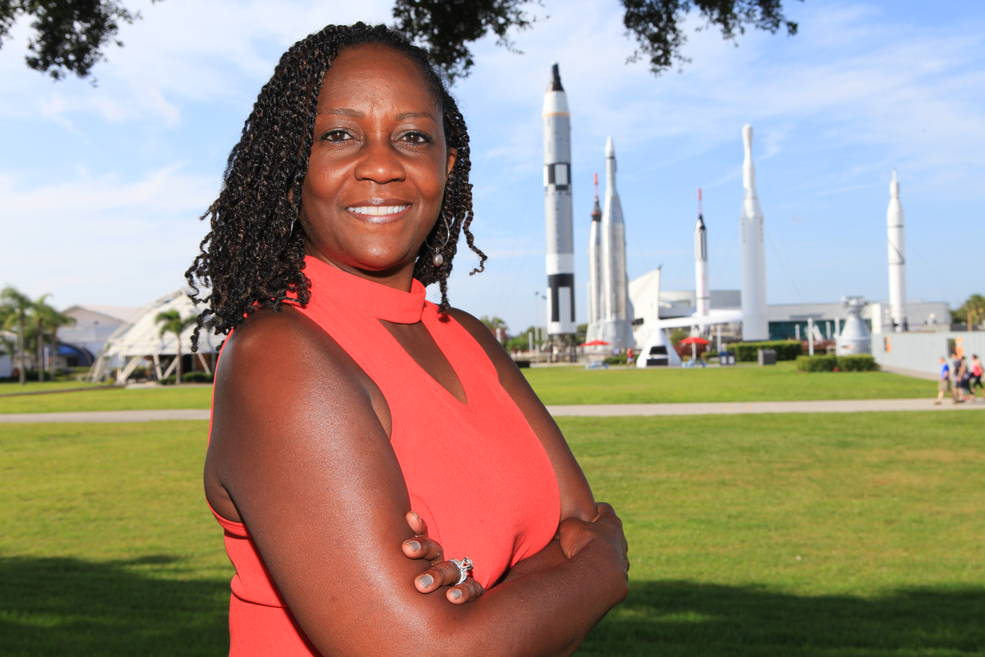Please explain your job in a single sentence.
My job entails monitoring contractors’ performance and delivery of products and/or services for their contracts, and I support the identification and establishment of the center’s partnerships and Space Act Agreements that enable the development and research of new technology.
What do you find most exciting about your job as Kennedy Space Center’s agreements integration manager,and how does that motivate you?
The most exciting part of my job as an agreements integration manager is to be involved in shaping innovative ideas by supporting and assisting the team with implementing new technology. Seeing the future of space being shaped by technology and applying better solutions for space travel is exciting. Working in the Exploration Research and Technology group allows me to be a part of changes made to an existing product, idea or field.
What is a typical day like for you?
During a typical day, I monitor agreements and update the team on in-work and active agreements. This includes identifying the appropriate type of agreement. I work with my team, the partnership office, the chief technologist and sometimes Legal to ensure the work is beneficial to the center’s mission. As the technical monitor representative and contracting officer representative for my team’s contracts, I develop, modify and review task orders provided by the contractors. I review inputs for award fee evaluations and monitor contractor performance and delivery of products or services under the contract. If a contract needs additional work content added, my job is to work with the contracting officer to ensure it is within the scope of the contract.
What is your educational background and why did you choose to study those areas?
I have a Bachelor of Science in electrical engineering and a Master of Business Administration. I chose engineering because I have an older sibling who majored in engineering. During his years in college I became fascinated by the math and science. Another motivator was that I had a high school teacher tell me I could never be an engineer because I was a female. At that point I set out to prove him wrong, and I did.
How do the era and place in which you grew up shape how you approach your work?
I grew up in a small town in Texas during a time when there were not many female engineers. I learned to give 110 percent daily to prove I belonged in this limited field. My dad always told me nothing good comes easy and now I see how those words hold true to life. I have gained respect from my peers, so the hard work paid off.
What motivated you to want to work for NASA?
One reason I wanted to work for NASA is that the projects will make a difference to society. I knew I would be able to use my talent and passion to contribute to the impact NASA has on the world. Also, I knew I would be able to work with the best of the best because NASA employs world-class, diverse talent to help tackle complex problems, and you never stop learning.
Why does conducting research and developing new technology matter to you?
Conducting research and developing new technology matters to me because The most rewarding part of working with this group is I can help people put their ideas, concepts and thoughts together, then see it fly into space.
What is the most challenging problem you have overcome or are currently working on at NASA?
One of the most challenging problems I have had to overcome here was to reinvent myself. My background is in flight software and avionics. When the Space Shuttle program ended I had to figure out how to best use my background at Johnson Space Center for future capabilities. That is the great part of working at NASA; there are many opportunities that bring together a range of people and perspective to foster innovation. The Research and Technology team gives me an opportunity to learn new technology as well as work with people that can help me expand my expertise.
Who is the most interesting, inspiring or amazing person you have met or worked with at NASA, and how did meeting that person affect you?
There are actually two people who inspired me at NASA. The first is Vanessa Wyche, director of the Exploration, Integration and Science Directorate. She was the first NASA manager I worked for. One of her quotes is, “You just have to have the confidence in yourself that if you don’t get that win, ask yourself what you can learn from it.” The other person is Jasen Raboin, who designed and patented workout equipment on the International Space Station and is now deputy division chief for Structural Engineering. He taught me that if you don’t try, you don’t get what you want. The inspiration from these two individuals has taught me how to attain goals, embrace change and contribute to transforming the world.
Do you have any advice for people about trying to foster innovation in their workplaces?
Each employee should be encouraged to do something he or she has never before attempted. Rejection is not failure. It can be used as a motivator to regroup, strategize and meet the challenge head on. Team innovation will also help the group. People should know their ideas are always important. Employees should be trusted to take safe risks and attempt new ways of doing things, and they might stumble across that next great idea.



























